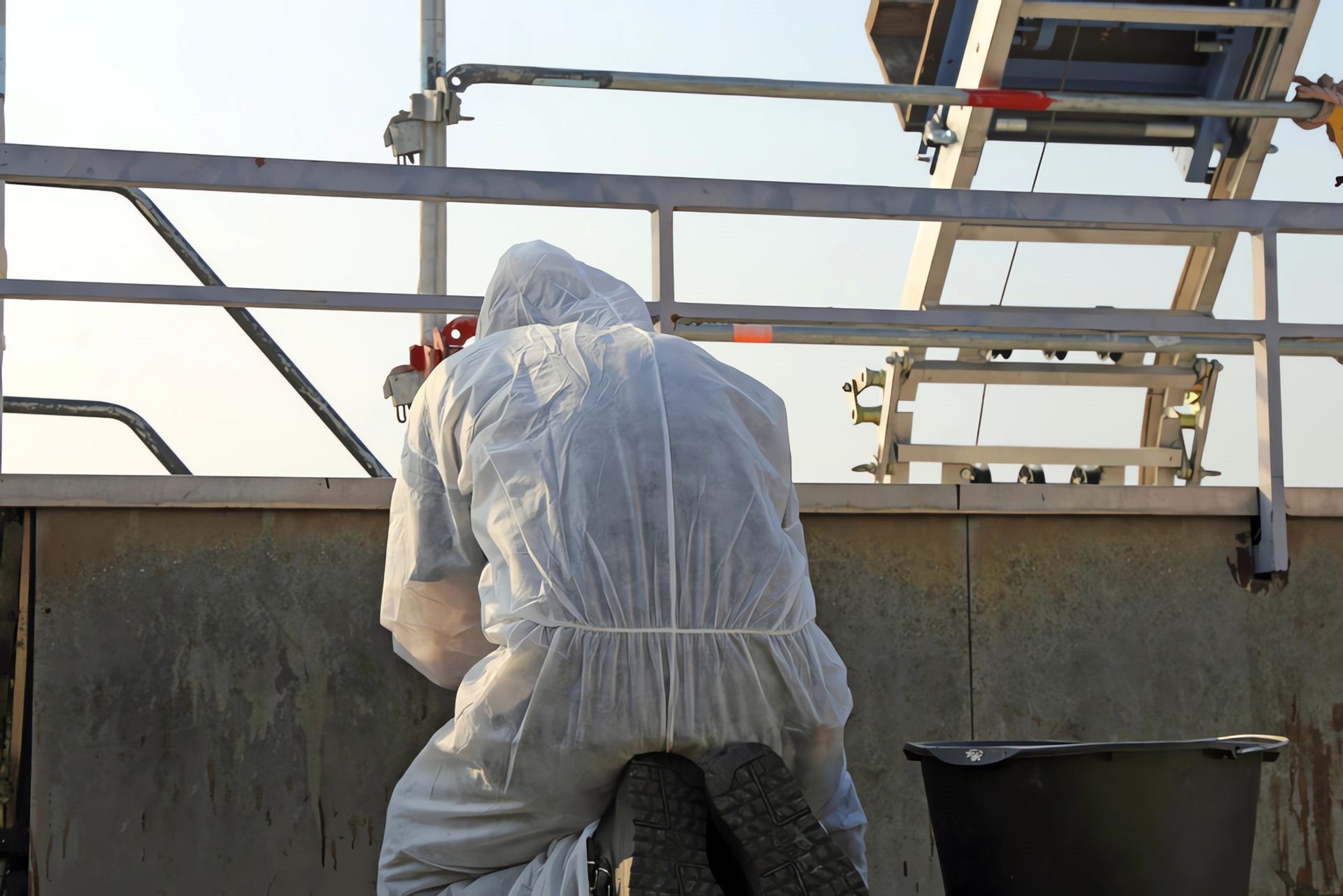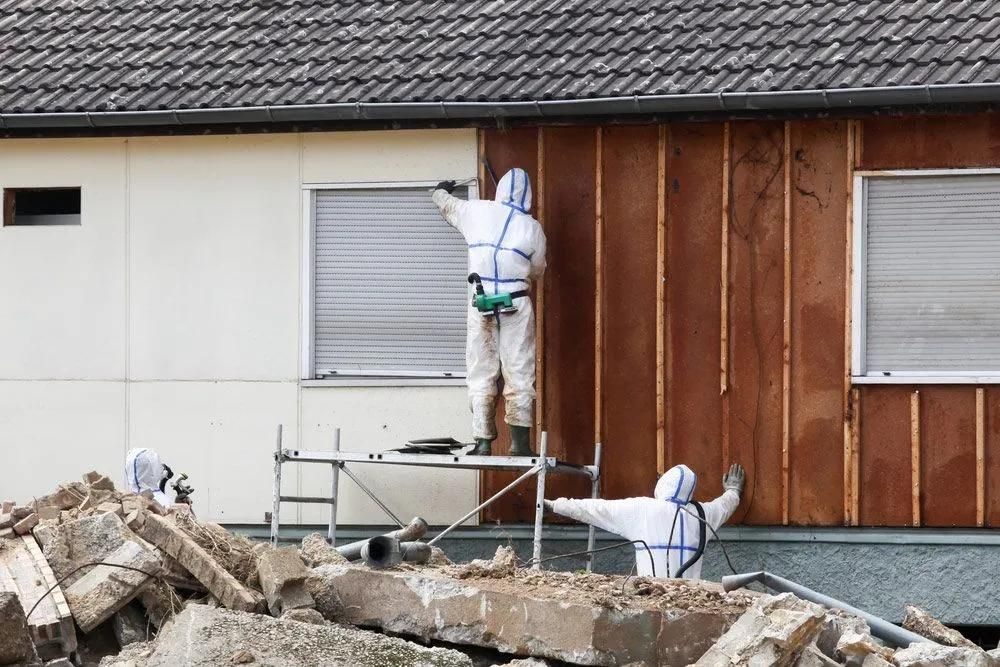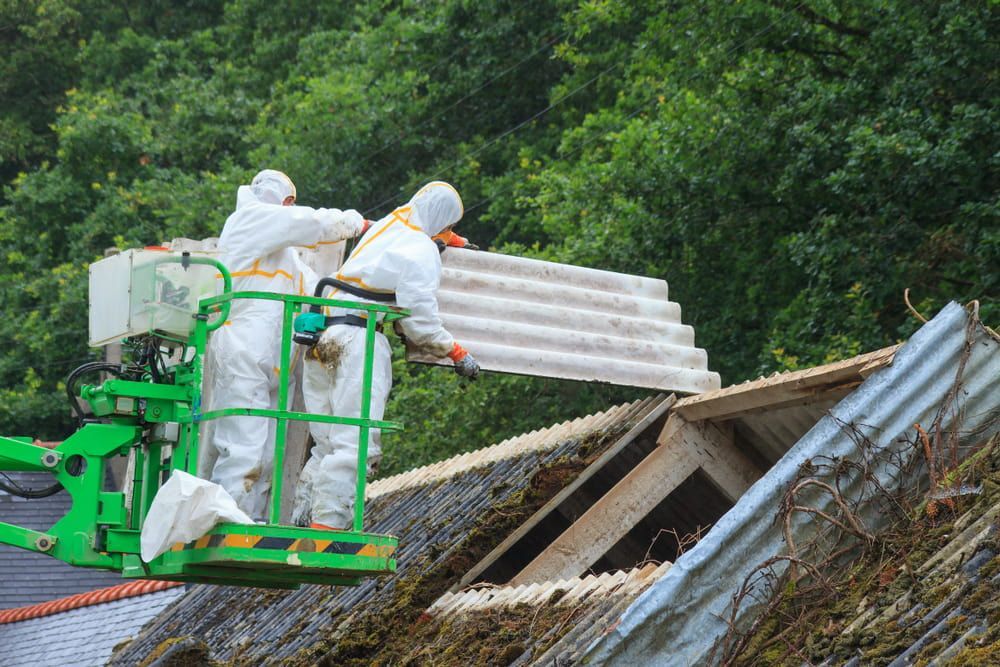Got asbestos containing materials on your industrial site? We'll take care of them for you.
Our team remove asbestos from residential properties throughout the Central Coast region.
Safe Asbestos Removals
Central Coast Complete Demolition provides safe and dependable asbestos removal and remediation services throughout the Central Coast, Newcastle and the Hunter Valley. We have been operating out of Tuggerah for more than 20 years.
What is Asbestos?
Often found in older houses, asbestos is a highly toxic material, especially when disturbed, and should be treated with caution. Asbestos is the name given to a group of silicate minerals that occur naturally in the environment as bundles of fibres. These minerals are either of the serpentine group or the amphibole group. Serpentine asbestos includes the mineral chrysotile, or ‘white asbestos’, which has long, curly fibres that can be woven. Because of asbestos’s many advantageous qualities such as strength, flexibility, heat stability, insulation properties, adsorption capacity and resistance to degradation, it has been used worldwide in numerous ways. The use in human culture dates back at least 4,500 years. The actual commercial use of asbestos began in the late 19th Century. Asbestos has been used in roofing, insulation and flooring materials, cement, gaskets, brakes, plastics, textiles and so on.
If you find signs of asbestos in your home, our team at Central Coast Complete Demolition will handle its removal with care. For expert help with asbestos removal on the Central Coast, get in touch with our team today, call us on 0428 170 278.
Safe Asbestos Removal Process
We are a licenced contractor for asbestos removals in NSW. Asbestos remediation is a detailed process that requires specialised knowledge and experience. When it comes to handling asbestos, you’ll want to know that you have professionals on the job. Our licenced and insured crew wears protective clothing and full safety gear including overalls, boots, P2 Masks and gloves. Every team member is dedicated to professionalism and fully adheres to all safety requirements.
What Does Our Asbestos Service Include?
- Asbestos surveys & analysis
- Site decontamination
- Asbestos containment
- Asbestos disposal
- Commercial, industrial & residential
If you need it done, we have the machinery to do it. Our diverse range of equipment includes 2.5-tonne and 8-tonne Daihatsu tippers, 8-tonne flat-top Hiab, 12-tonne Bogey tippers, 24 ft and 32ft semi tippers, semi-low loaders and several 16-tonne twin-steer tippers.
Our Fleet of Excavators
Our well-maintained fleet of excavators includes: 2.5-tonne, 3.5-tonne, 4.5-tonne, 5.5-tonne, 6-tonne, 7-tonne, 7.5-tonne, 12-tonne, 14-tonne, 21-tonne, 25-tonne, 31-tonne and 35-tonne models. Our excavators can be fitted with a versatile range of attachments. When you engage with Central Coast Complete Demolition, you are in the best hands when it comes to keeping you and your environment safe. We care significantly about environmental conservation and we take every measure to ensure the least ecological impact while providing our expert asbestos remediation services.
Get Educated on the Dangers of Asbestos
We support the Pleural Mesothelioma Center, which is an advocacy group providing extensive information on asbestos and the diseases it causes. They are dedicated to educating people on the dangers of asbestos and how to stay safe if they suspect it in their home. Pleural mesothelioma is the most common form of mesothelioma, the cancer caused by asbestos.
Where is Asbestos Commonly Found In Homes?
Asbestos is commonly found in a number of household areas including underneath kitchen and bathroom tiles, within the walls, as well as surrounding hot water pipes within brick homes. In backyards or the exterior of the home, asbestos is commonly found in flat, patterned and corrugated wall and roof sheeting, underneath eaves, in electrical meter boards and around the roof, gutters and downpipes.
Is Asbestos Prohibited in Australia?
While asbestos has been a prohibited product in Australia since December 2003, in many countries it is still used in manufactured products. Certification provided to importers from overseas manufacturers that goods are asbestos-free have sometimes found to be wrong for the purposes of our regulations. Local standards in some supplier countries may classify goods ‘asbestos free’ where they meet a certain low level of asbestos content. In Australia, a product found with any level of asbestos is prohibited for import or use. Importers should be aware of the varying definitions and standards applied in the country of origin and/or supply. Australian regulations apply at the border. The importer must ensure they do not import asbestos into Australia. They should:
- Request certification from the manufacturer that the goods are asbestos-free
- Obtain evidence from the overseas supplier, e.g. product testing results that the product/material does not contain asbestos
- Arrange a competent person to sample the goods/materials for testing by a laboratory prior to shipping (It is recommended that a NATA accredited laboratory, accredited for the relevant test method (AS 4964 Method for the qualitative identification of asbestos in bulk samples), or internationally equivalent laboratories be used)
We Provide Asbestos Removal Across the Central Coast
Our asbestos remediation team services clients based in Budgewoi, Buff Point,
Gosford, Tuggerah,
Wyong, Central Coast, The Entrance, Long Jetty, Bateau Bay, Shelly Beach, Terrigal and all Hunter regions and Northern areas such as Nelsons Bay, Hawks Nest and Forster. Ask us about service outside of these areas and we will do our best to accommodate you.
The Risks of DIY Asbestos Removal: Why You Should Leave It to the Experts
When it comes to dealing with asbestos-containing materials (ACMs) in your property, the idea of attempting DIY asbestos removal may seem tempting, especially if you're looking to save on costs. However, asbestos removal is a highly specialised process that involves significant health, legal and safety risks. In Australia, the handling and removal of asbestos are strictly regulated, and failure to adhere to proper procedures can lead to severe consequences, including exposure to dangerous fibres, environmental contamination and hefty fines. That's why it's always advisable to hire professionals for asbestos removal on the Central Coast.
The Health Risks of Asbestos Exposure
Asbestos is a hazardous material that can cause serious respiratory diseases when its fibres are inhaled. Over time, these tiny, microscopic fibres can accumulate in the lungs, leading to conditions such as asbestosis, lung cancer and mesothelioma. DIY removal can disturb asbestos fibres, releasing them into the air and significantly increasing the risk of exposure to yourself, your family and anyone nearby. In many cases, people who unknowingly handle asbestos without the proper precautions end up suffering from diseases years later. The professional handling of asbestos removal on the Central Coast ensures that all proper safety measures are in place to protect human health during the process.
Improper disposal of asbestos is another serious concern. If you remove asbestos and dispose of it incorrectly—such as dumping it in an ordinary waste bin or in an unapproved landfill—you could face severe legal penalties. Professionals trained in asbestos removal on the Central Coast are well-versed in proper disposal procedures, ensuring that the hazardous material is taken to licensed waste facilities where it will be safely managed.
The Technical Challenges of Asbestos Removal
Asbestos removal isn't as simple as just tearing out old materials. The process requires specialised equipment, knowledge and training to handle the material safely. Here are some reasons why DIY asbestos removal is dangerous.
- Risk of disturbing asbestos fibres: Without the proper containment methods, removal can release harmful fibres into the air, putting you and others at risk of inhaling them.
- Lack of proper protective gear: Asbestos removal requires the use of personal protective equipment (PPE), including disposable coveralls, respirators and gloves, to prevent exposure.
- Improper sealing and disposal: Without knowledge of the proper sealing techniques, asbestos debris can easily spread to other areas of the home.
- No air monitoring: Professionals monitor air quality throughout the removal process to ensure it is safe to proceed. DIY removal lacks this critical step.
What to Expect During Asbestos Removal
When it comes to asbestos removal, understanding what to expect throughout the process is essential for ensuring safety, efficiency and peace of mind. Asbestos is a hazardous material that requires careful handling and specialised knowledge. Whether you're preparing for asbestos removal on the Central Coast in a residential or commercial setting, the following steps outline the process and what you can expect when you hire professionals for the job.
1. Initial Inspection & Risk Assessment
The first step in asbestos removal is an initial site inspection. A qualified professional will visit the property to assess the presence of asbestos-containing materials (ACMs). During this phase, they will identify materials such as ceiling tiles, insulation, flooring or roofing that may contain asbestos. The professional will also evaluate the condition of the materials—whether they are damaged or intact, as this will affect the level of risk during removal.
After the inspection, a risk assessment is carried out to determine the necessary precautions. This includes deciding whether to proceed with removal immediately or if the materials can remain safely undisturbed. For homes or buildings with ACMs that pose a high risk of exposure, asbestos removal services will proceed promptly with appropriate containment measures.
2. Safe Containment & Preparation
Before starting the removal, the work area must be properly sealed off to prevent asbestos fibres from spreading into the rest of the building. This involves setting up physical barriers, including plastic sheeting or negative air pressure units to control airflow and keep contaminated air contained. All windows, doors and vents leading to other areas will be sealed to ensure that fibres do not escape.
The professionals will also wear protective clothing such as disposable coveralls, gloves and respirators to prevent personal exposure to asbestos fibres. Equipment and tools used for removal will be thoroughly cleaned before and after the procedure to minimise contamination.
3. Asbestos Removal Process
Once the area is properly contained and preparations are made, the asbestos removal process can begin. The professional team will carefully remove the ACMs using specialised tools to minimise dust and fibre release. In some cases, materials will be wetted to reduce the chance of airborne fibres, ensuring a safer removal process. The materials will then be carefully packed into sealed containers for safe transport.
The removal of asbestos should be done with great care to prevent disturbing other areas of the building or spreading asbestos fibres to other parts of the property.
4. Air Monitoring & Clearance
After the removal is complete, air monitoring is conducted to ensure that the area is free from harmful asbestos fibres. Professionals will use specialised equipment to test the air quality and verify that it meets the safety standards before allowing anyone to re-enter the area. Only once the air quality is deemed safe will the area be cleared for use. This stage is crucial, as it ensures that there is no lingering contamination.
5. Proper Disposal & Final Cleanup
The final step in the process involves the safe disposal of the removed asbestos materials. Professional asbestos removal companies are trained in disposing of asbestos safely, following all local and national regulations. The materials will be transported to a licensed disposal facility, where they will be handled in accordance with environmental laws to ensure there is no further contamination.
After disposal, the work area is thoroughly cleaned and checked again for safety. Any tools or equipment used in the removal are cleaned and disinfected to avoid cross-contamination. The site is now ready for construction, renovation or occupancy without any lingering health risks.
How Asbestos Removal Improves Property Value
Asbestos is a hazardous material that was commonly used in construction prior to the 1980s. Many older homes, commercial properties and buildings across Australia still contain asbestos-containing materials (ACMs) that pose significant health risks. While the presence of asbestos in a property may not immediately impact its structural integrity, it can certainly affect its value and the safety of its occupants. Asbestos removal is a crucial step in maintaining a healthy, safe living or working environment while also enhancing the overall value of the property. If you're considering asbestos removal on the Central Coast, here’s why it’s a worthwhile investment.
Improving Property Value
Asbestos can drastically lower the market value of a property, whether you're planning to sell, rent or simply maintain your investment. In Australia, buyers are increasingly aware of the risks associated with asbestos, and properties containing these materials are often seen as liabilities. The cost of removing asbestos is a key consideration for potential buyers, and properties with known asbestos issues may be priced lower to account for these removal costs.
- Increased buyer confidence: Knowing that the property is free from harmful materials like asbestos gives potential buyers peace of mind. They won’t have to worry about hazardous material removal, which can be expensive and complicated.
- Higher selling price: Properties without asbestos can command a higher price on the market because they are safer and require fewer renovations.
- Quicker sale: Buyers are often reluctant to purchase homes or commercial properties with asbestos, fearing the hidden costs associated with removal. By addressing the issue upfront, you increase the likelihood of a faster sale at a better price.
Asbestos removal is not just about eliminating a health risk; it’s an investment in your property’s future. Whether you're looking to sell, renovate or simply ensure a safe environment for your family or employees, removing asbestos is a crucial step. For professional, safe and efficient asbestos removal, choose Central Coast Complete Demolition to handle the job with care and expertise.
The Technical Challenges of Asbestos Removal
Asbestos removal isn't as simple as just tearing out old materials. The process requires specialised equipment, knowledge and training to handle the material safely. Here are some reasons why DIY asbestos removal is dangerous.
- Risk of disturbing asbestos fibres: Without the proper containment methods, removal can release harmful fibres into the air, putting you and others at risk of inhaling them.
- Lack of proper protective gear: Asbestos removal requires the use of personal protective equipment (PPE), including disposable coveralls, respirators and gloves, to prevent exposure.
- Improper sealing and disposal: Without knowledge of the proper sealing techniques, asbestos debris can easily spread to other areas of the home.
- No air monitoring: Professionals monitor air quality throughout the removal process to ensure it is safe to proceed. DIY removal lacks this critical step.
Frequently Asked Questions
How do I know which materials in my home or business contain asbestos?
The short answer is that you won't know unless the material is professionally tested. Although older materials are more likely to contain asbestos than modern ones, there's no way to visually distinguish a piece of plasterboard or cement that contains asbestos from a similar material that doesn't contain it.
Does asbestos always have to be removed?
No. In some circumstances, it may be more dangerous to remove it than it is to leave it in position. If the asbestos is tightly bonded (for example in asbestos cement) and in good repair, if it's painted and not subject to traffic, it's probably best left alone. Your asbestos professional will be able to advise on how best to manage any installations that have tested positive for asbestos in your property.
Are some types of asbestos more dangerous than others?
Yes and no. Some studies have shown that people exposed to asbestos fibres are more susceptible to disease if they inhale amphibole asbestos (blue or brown asbestos) rather than white, chrysotile asbestos. That said, all asbestos fibres, including chrysotile, have the potential to cause serious illness if inhaled. Individuals have different tolerances - for some people, even a small exposure may be enough to trigger disease; in other cases, individuals can be exposed to large quantities of asbestos and remain unaffected. It is best to always err on the side of caution when dealing with asbestos.
I have discovered I have asbestos in my home, what should I do?
If a sample of a material in your property has tested positive for asbestos, your asbestos professional will advise on the level of risk it presents - for example, a large amount of loosely packed, ageing asbestos insulation presents a higher risk than a small amount of painted asbestos cement in good condition. Based on their recommendations, you can implement a suitable management plan to minimise risk in your property to you and your family.
Do homes built after 2003 contain asbestos?
Although the use of asbestos materials after 2003 was banned, there's no guarantee that some may not have found their way into your home. Anything from builders using asbestos materials inadvertently through to subsequent owners doing DIY with old, asbestos-containing materials they've got lying about could result in asbestos in your home. As always, if in doubt, arrange for professional sample testing so you know what you're dealing with.











